

9 grade
Дипломдар мен сертификаттарды алып үлгеріңіз!

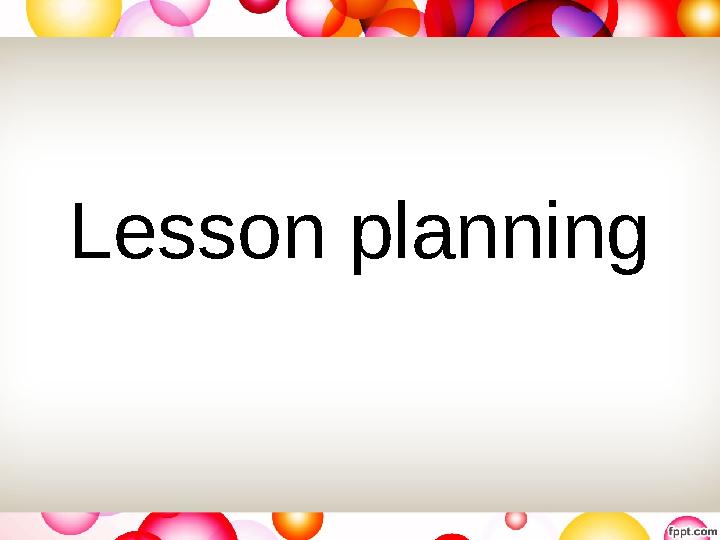

1 слайд
Lesson planning
1 слайд
Lesson planning
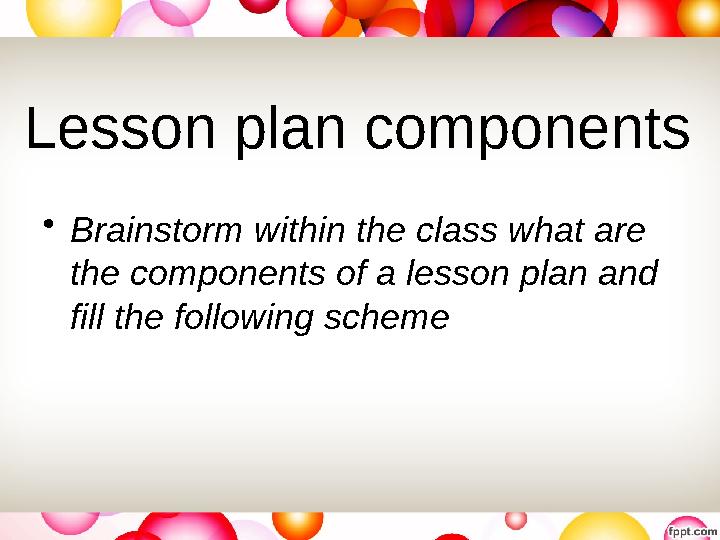
2 слайд
Lesson plan components
•
Brainstorm within the class what are
the components of a lesson plan and
fill the following scheme
2 слайд
Lesson plan components • Brainstorm within the class what are the components of a lesson plan and fill the following scheme
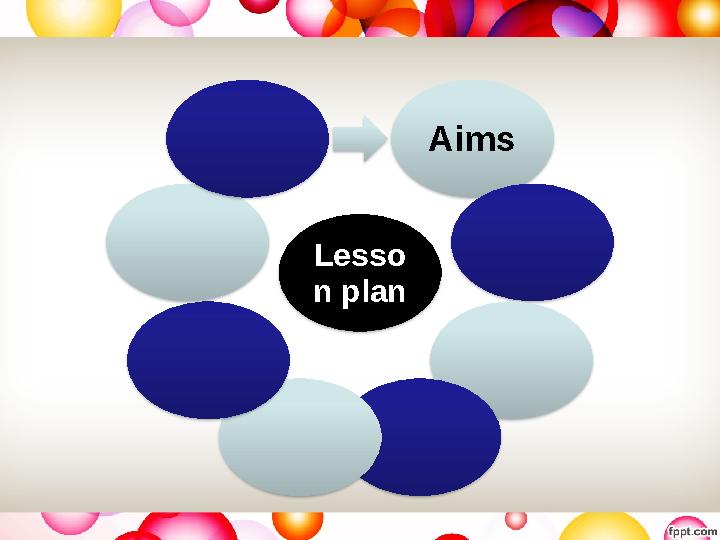
3 слайд
Lesso
n plan Aims
3 слайд
Lesso n plan Aims
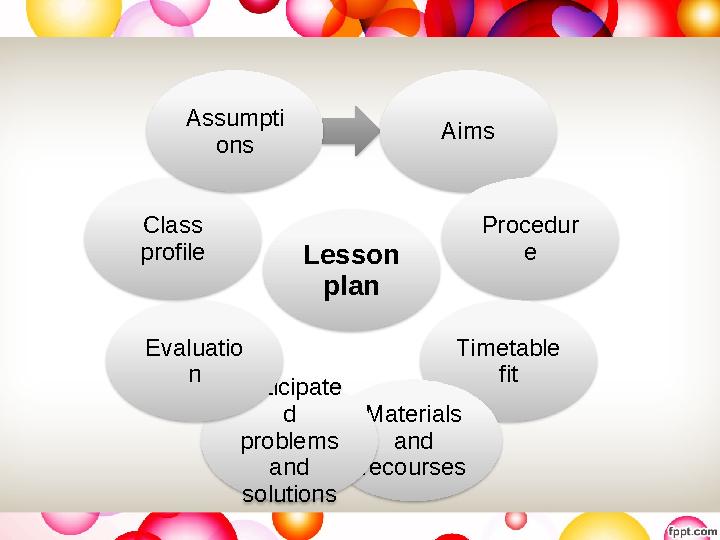
4 слайд
Lesson
plan Aims
Procedur
e
Timetable
fit
Materials
and
recoursesAnticipate
d
problems
and
solutionsEvaluatio
nClass
profile Assumpti
ons
4 слайд
Lesson plan Aims Procedur e Timetable fit Materials and recoursesAnticipate d problems and solutionsEvaluatio nClass profile Assumpti ons
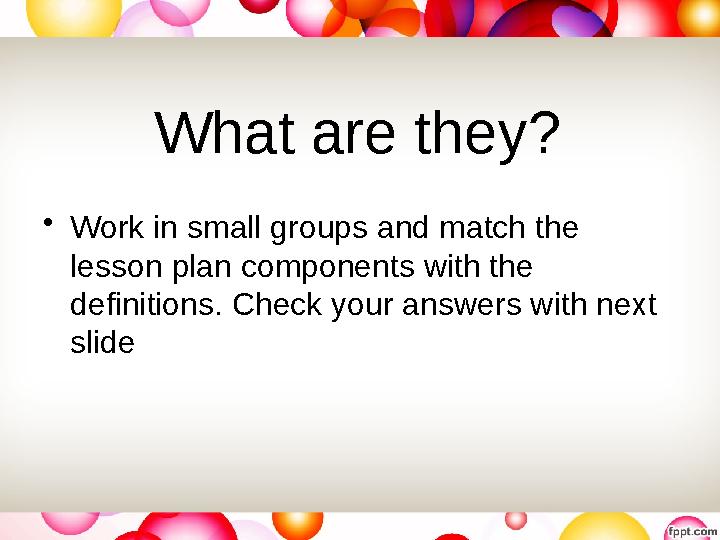
5 слайд
What are they?
•
Work in small groups and match the
lesson plan components with the
definitions. Check your answers with next
slide
5 слайд
What are they? • Work in small groups and match the lesson plan components with the definitions. Check your answers with next slide
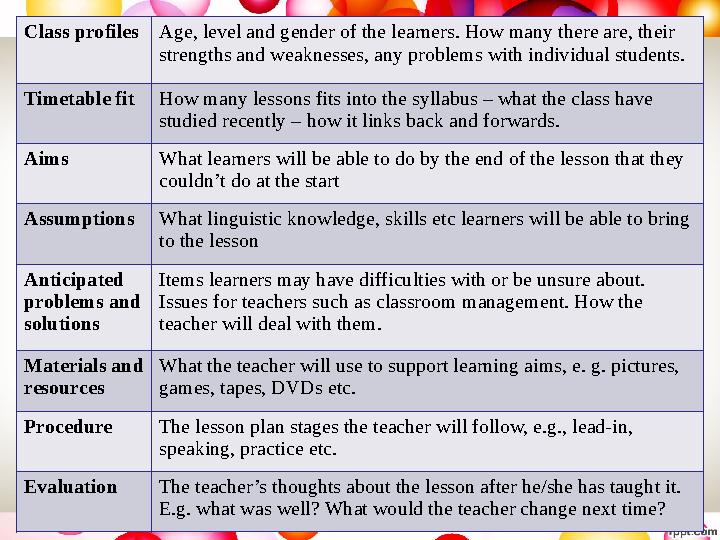
6 слайд
Class profiles Age, level and gender of the learners. How many there are, their
strengths and weaknesses, any problems with individual students.
Timetable fit How many lessons fits into the syllabus – what the class have
studied recently – how it links back and forwards.
Aims What learners will be able to do by the end of the lesson that they
couldn’t do at the start
Assumptions What linguistic knowledge, skills etc learners will be able to bring
to the lesson
Anticipated
problems and
solutions Items learners may have difficulties with or be unsure about.
Issues for teachers such as classroom management. How the
teacher will deal with them.
Materials and
resources What the teacher will use to support learning aims, e. g. pictures,
games, tapes, DVDs etc.
Procedure The lesson plan stages the teacher will follow, e.g., lead-in,
speaking, practice etc.
Evaluation The teacher’s thoughts about the lesson after he/she has taught it.
E.g. what was well? What would the teacher change next time?
6 слайд
Class profiles Age, level and gender of the learners. How many there are, their strengths and weaknesses, any problems with individual students. Timetable fit How many lessons fits into the syllabus – what the class have studied recently – how it links back and forwards. Aims What learners will be able to do by the end of the lesson that they couldn’t do at the start Assumptions What linguistic knowledge, skills etc learners will be able to bring to the lesson Anticipated problems and solutions Items learners may have difficulties with or be unsure about. Issues for teachers such as classroom management. How the teacher will deal with them. Materials and resources What the teacher will use to support learning aims, e. g. pictures, games, tapes, DVDs etc. Procedure The lesson plan stages the teacher will follow, e.g., lead-in, speaking, practice etc. Evaluation The teacher’s thoughts about the lesson after he/she has taught it. E.g. what was well? What would the teacher change next time?
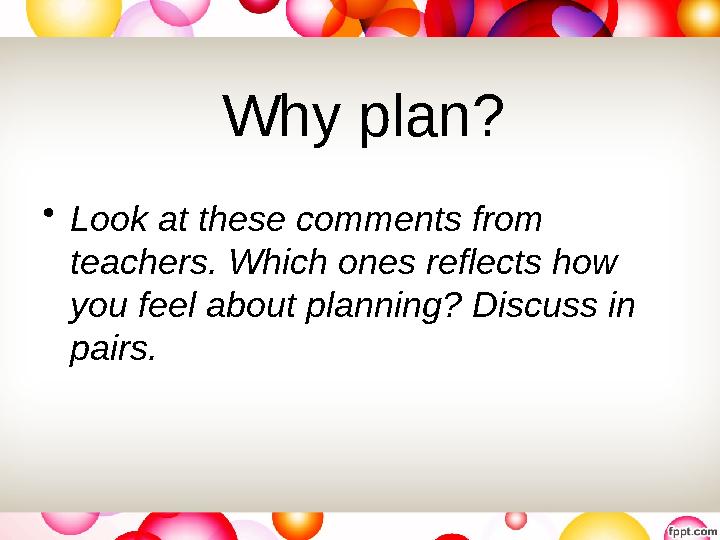
7 слайд
Why plan?
•
Look at these comments from
teachers. Which ones reflects how
you feel about planning? Discuss in
pairs.
7 слайд
Why plan? • Look at these comments from teachers. Which ones reflects how you feel about planning? Discuss in pairs.

8 слайд
I don’t have time to
planI think it’s important
to have aims
I never stick to
plans The textbook is my
plan
Planning helps me to
teach more efficiently I don’t do detailed plan,
but make rough notes
8 слайд
I don’t have time to planI think it’s important to have aims I never stick to plans The textbook is my plan Planning helps me to teach more efficiently I don’t do detailed plan, but make rough notes
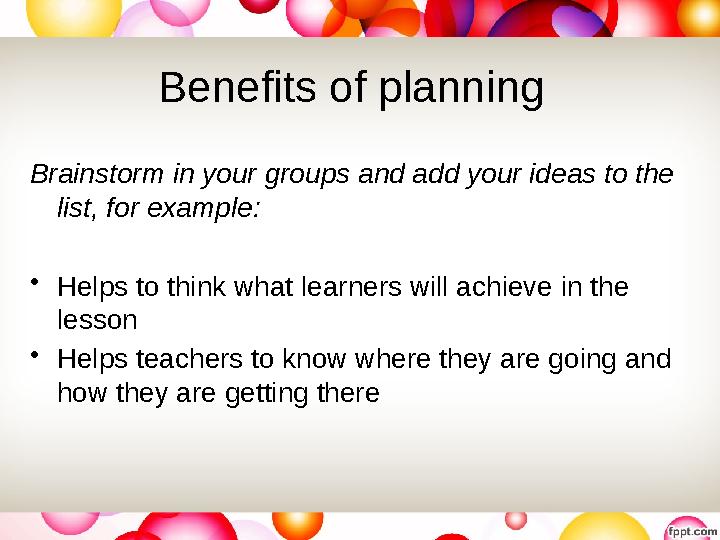
9 слайд
Benefits of planning
Brainstorm in your groups and add your ideas to the
list, for example:
•
Helps to think what learners will achieve in the
lesson
•
Helps teachers to know where they are going and
how they are getting there
9 слайд
Benefits of planning Brainstorm in your groups and add your ideas to the list, for example: • Helps to think what learners will achieve in the lesson • Helps teachers to know where they are going and how they are getting there

10 слайд
•
Provides the framework for organizing ideas, methodology,
materials etc.
•
Helps make the lesson coherent.
•
Avoids over – domination of coursbooks.
•
Demonstrates to learners that teacher knows what he/she’s
doing
•
Being prepared boosts teacher confidence
•
Helps to identify any problems or difficulties which may arise
during the lesson
•
Helps teacher to adapt to different classes
•
Developmental – a learning document for teachers to reflect
on after the lesson.
•
Helps to identify the kinds of activities and materials to include
to achieve aims
•
A plan can link the lesson explicitly to syllabus objectives
10 слайд
• Provides the framework for organizing ideas, methodology, materials etc. • Helps make the lesson coherent. • Avoids over – domination of coursbooks. • Demonstrates to learners that teacher knows what he/she’s doing • Being prepared boosts teacher confidence • Helps to identify any problems or difficulties which may arise during the lesson • Helps teacher to adapt to different classes • Developmental – a learning document for teachers to reflect on after the lesson. • Helps to identify the kinds of activities and materials to include to achieve aims • A plan can link the lesson explicitly to syllabus objectives
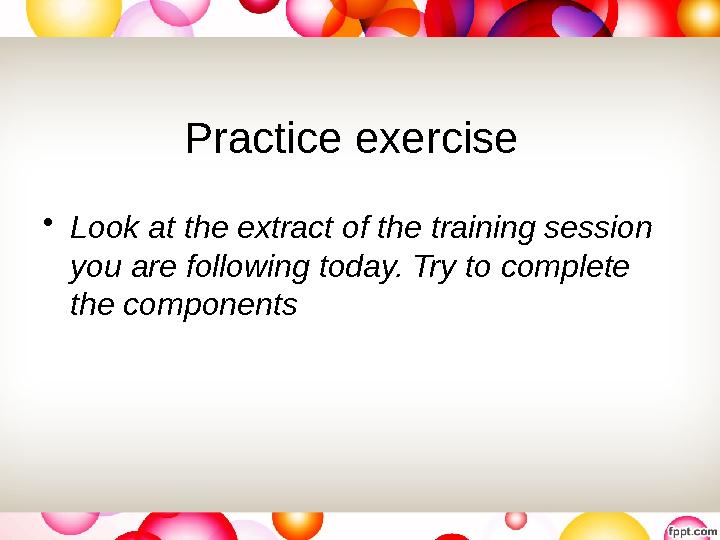
11 слайд
Practice exercise
•
Look at the extract of the training session
you are following today. Try to complete
the components
11 слайд
Practice exercise • Look at the extract of the training session you are following today. Try to complete the components
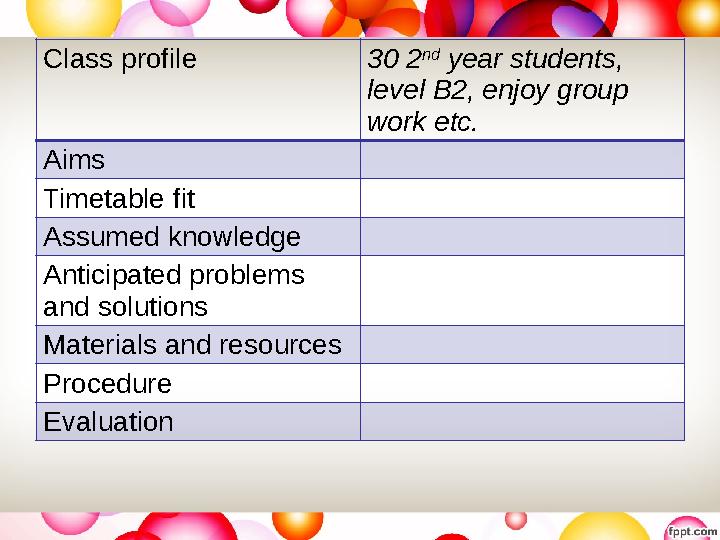
12 слайд
Class profile 30 2 nd
year students,
level B2, enjoy group
work etc.
Aims
Timetable fit
Assumed knowledge
Anticipated problems
and solutions
Materials and resources
Procedure
Evaluation
12 слайд
Class profile 30 2 nd year students, level B2, enjoy group work etc. Aims Timetable fit Assumed knowledge Anticipated problems and solutions Materials and resources Procedure Evaluation

13 слайд
Class profile 30 2 nd
year students, level B2, enjoy group
work etc.
Aims To enable participants to distinguish the
different components of the lesson and
establish the advantages of lesson planning
Timetable fit Participant have recently discussed
classroom management and in the next
stage will discuss how to set up effective
aims
Assumed
knowledge This will vary from group to group, e.g.
students will be familiar with lesson plans
though they may have different ideas of
what components are.
13 слайд
Class profile 30 2 nd year students, level B2, enjoy group work etc. Aims To enable participants to distinguish the different components of the lesson and establish the advantages of lesson planning Timetable fit Participant have recently discussed classroom management and in the next stage will discuss how to set up effective aims Assumed knowledge This will vary from group to group, e.g. students will be familiar with lesson plans though they may have different ideas of what components are.
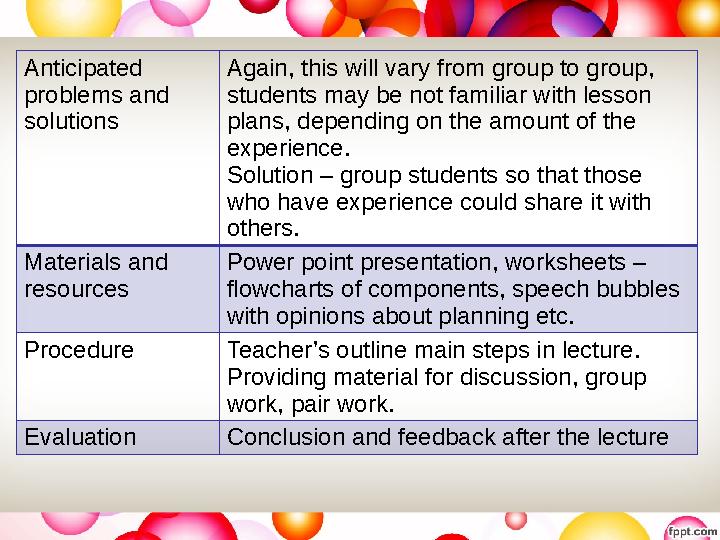
14 слайд
Anticipated
problems and
solutions Again, this will vary from group to group,
students may be not familiar with lesson
plans, depending on the amount of the
experience.
Solution – group students so that those
who have experience could share it with
others.
Materials and
resources Power point presentation, worksheets –
flowcharts of components, speech bubbles
with opinions about planning etc.
Procedure Teacher’s outline main steps in lecture.
Providing material for discussion, group
work, pair work.
Evaluation Conclusion and feedback after the lecture
14 слайд
Anticipated problems and solutions Again, this will vary from group to group, students may be not familiar with lesson plans, depending on the amount of the experience. Solution – group students so that those who have experience could share it with others. Materials and resources Power point presentation, worksheets – flowcharts of components, speech bubbles with opinions about planning etc. Procedure Teacher’s outline main steps in lecture. Providing material for discussion, group work, pair work. Evaluation Conclusion and feedback after the lecture
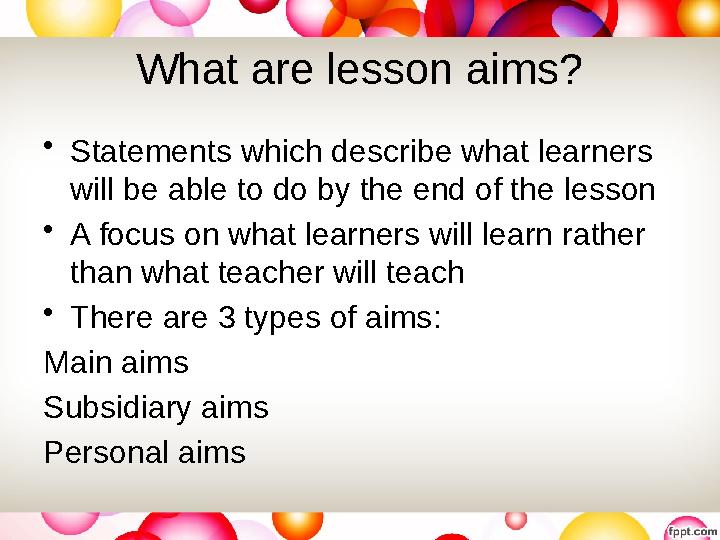
15 слайд
What are lesson aims?
•
Statements which describe what learners
will be able to do by the end of the lesson
•
A focus on what learners will learn rather
than what teacher will teach
•
There are 3 types of aims:
Main aims
Subsidiary aims
Personal aims
15 слайд
What are lesson aims? • Statements which describe what learners will be able to do by the end of the lesson • A focus on what learners will learn rather than what teacher will teach • There are 3 types of aims: Main aims Subsidiary aims Personal aims
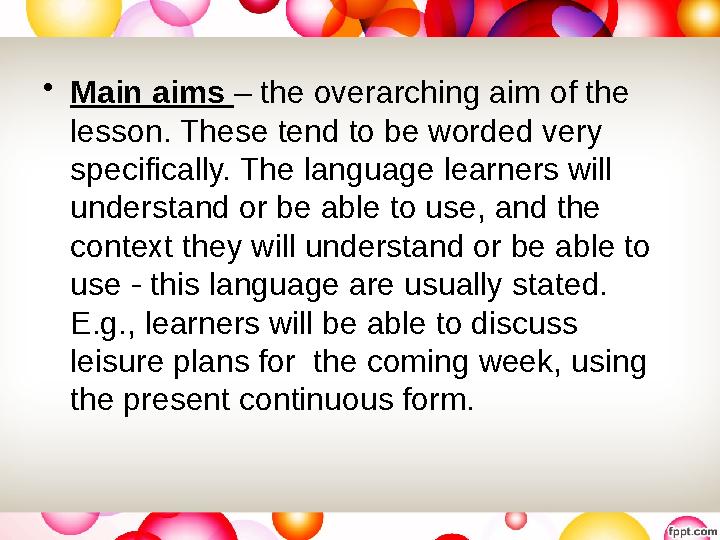
16 слайд
•
Main aims – the overarching aim of the
lesson. These tend to be worded very
specifically. The language learners will
understand or be able to use, and the
context they will understand or be able to
use - this language are usually stated.
E.g., learners will be able to discuss
leisure plans for the coming week, using
the present continuous form.
16 слайд
• Main aims – the overarching aim of the lesson. These tend to be worded very specifically. The language learners will understand or be able to use, and the context they will understand or be able to use - this language are usually stated. E.g., learners will be able to discuss leisure plans for the coming week, using the present continuous form.

17 слайд
•
Subsidiary aims – second in importance
of main aims (usually called objectives).
These tend to be worded less specifically
than main aims, and are liked to the main
aims of the lessons. E.g.: to enable
learners to review / activate previously
learnt lexis relating to leisure interests
17 слайд
• Subsidiary aims – second in importance of main aims (usually called objectives). These tend to be worded less specifically than main aims, and are liked to the main aims of the lessons. E.g.: to enable learners to review / activate previously learnt lexis relating to leisure interests
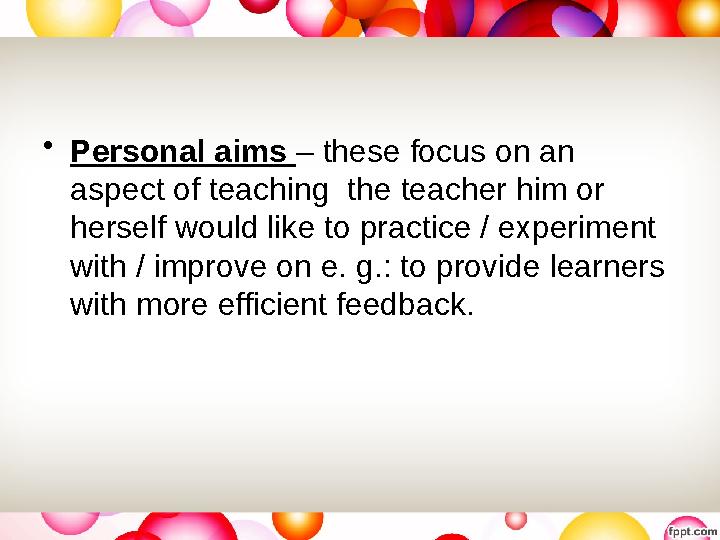
18 слайд
•
Personal aims – these focus on an
aspect of teaching the teacher him or
herself would like to practice / experiment
with / improve on e. g.: to provide learners
with more efficient feedback.
18 слайд
• Personal aims – these focus on an aspect of teaching the teacher him or herself would like to practice / experiment with / improve on e. g.: to provide learners with more efficient feedback.
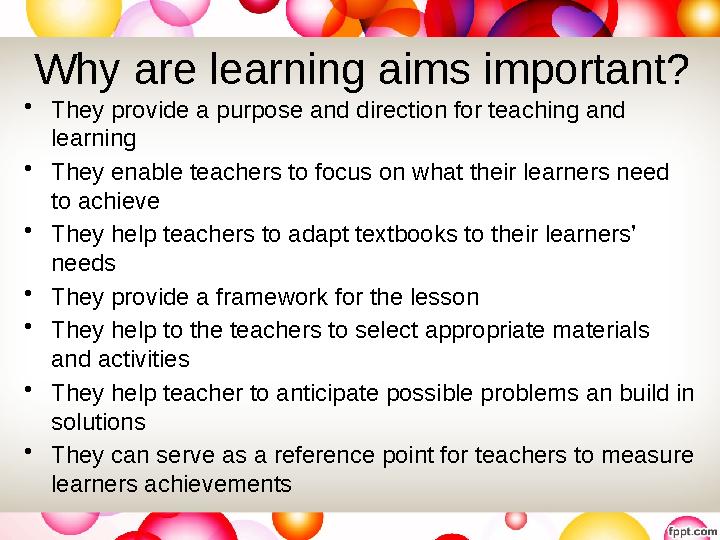
19 слайд
Why are learning aims important?
•
They provide a purpose and direction for teaching and
learning
•
They enable teachers to focus on what their learners need
to achieve
•
They help teachers to adapt textbooks to their learners’
needs
•
They provide a framework for the lesson
•
They help to the teachers to select appropriate materials
and activities
•
They help teacher to anticipate possible problems an build in
solutions
•
They can serve as a reference point for teachers to measure
learners achievements
19 слайд
Why are learning aims important? • They provide a purpose and direction for teaching and learning • They enable teachers to focus on what their learners need to achieve • They help teachers to adapt textbooks to their learners’ needs • They provide a framework for the lesson • They help to the teachers to select appropriate materials and activities • They help teacher to anticipate possible problems an build in solutions • They can serve as a reference point for teachers to measure learners achievements

20 слайд
Writing effective aims
•
Look at these two aims. Whish one do you think
more efficient? Which one is less efficient?
1) Learners will be able to use the present perfect
simple to describe situations in their live which
began in the past and are still true now.
2) To teach the present perfect simple with time
adverbials
Now think of an effective aim. What makes it less
effective? How do you check aims are
effective? Brainstorm the ideas and criteria for
effective aims.
20 слайд
Writing effective aims • Look at these two aims. Whish one do you think more efficient? Which one is less efficient? 1) Learners will be able to use the present perfect simple to describe situations in their live which began in the past and are still true now. 2) To teach the present perfect simple with time adverbials Now think of an effective aim. What makes it less effective? How do you check aims are effective? Brainstorm the ideas and criteria for effective aims.
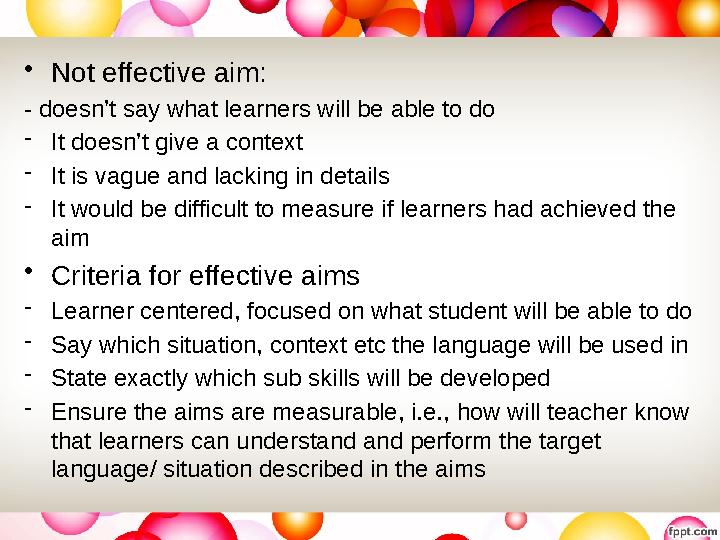
21 слайд
•
Not effective aim:
- doesn’t say what learners will be able to do
-
It doesn’t give a context
-
It is vague and lacking in details
-
It would be difficult to measure if learners had achieved the
aim
•
Criteria for effective aims
-
Learner centered, focused on what student will be able to do
-
Say which situation, context etc the language will be used in
-
State exactly which sub skills will be developed
-
Ensure the aims are measurable, i.e., how will teacher know
that learners can understand and perform the target
language/ situation described in the aims
21 слайд
• Not effective aim: - doesn’t say what learners will be able to do - It doesn’t give a context - It is vague and lacking in details - It would be difficult to measure if learners had achieved the aim • Criteria for effective aims - Learner centered, focused on what student will be able to do - Say which situation, context etc the language will be used in - State exactly which sub skills will be developed - Ensure the aims are measurable, i.e., how will teacher know that learners can understand and perform the target language/ situation described in the aims
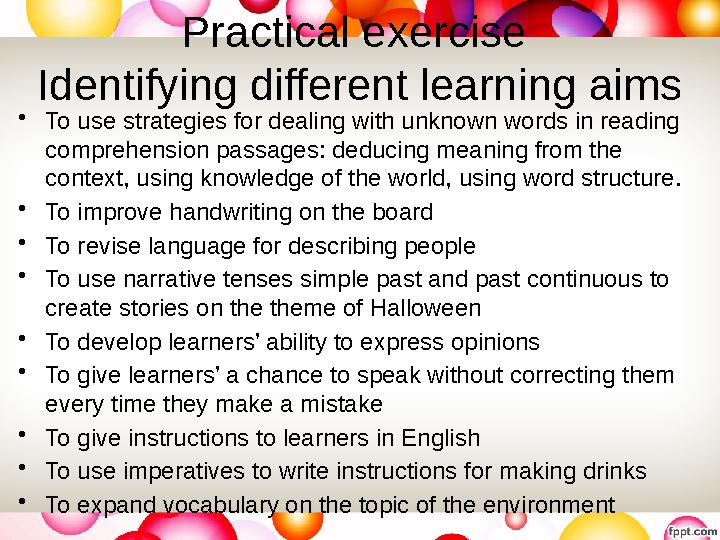
22 слайд
Practical exercise
Identifying different learning aims
•
To use strategies for dealing with unknown words in reading
comprehension passages: deducing meaning from the
context, using knowledge of the world, using word structure.
•
To improve handwriting on the board
•
To revise language for describing people
•
To use narrative tenses simple past and past continuous to
create stories on the theme of Halloween
•
To develop learners’ ability to express opinions
•
To give learners’ a chance to speak without correcting them
every time they make a mistake
•
To give instructions to learners in English
•
To use imperatives to write instructions for making drinks
•
To expand vocabulary on the topic of the environment
22 слайд
Practical exercise Identifying different learning aims • To use strategies for dealing with unknown words in reading comprehension passages: deducing meaning from the context, using knowledge of the world, using word structure. • To improve handwriting on the board • To revise language for describing people • To use narrative tenses simple past and past continuous to create stories on the theme of Halloween • To develop learners’ ability to express opinions • To give learners’ a chance to speak without correcting them every time they make a mistake • To give instructions to learners in English • To use imperatives to write instructions for making drinks • To expand vocabulary on the topic of the environment

23 слайд
Lesson stages
•
Match the lesson stage to the description,
discuss with a partner.
23 слайд
Lesson stages • Match the lesson stage to the description, discuss with a partner.
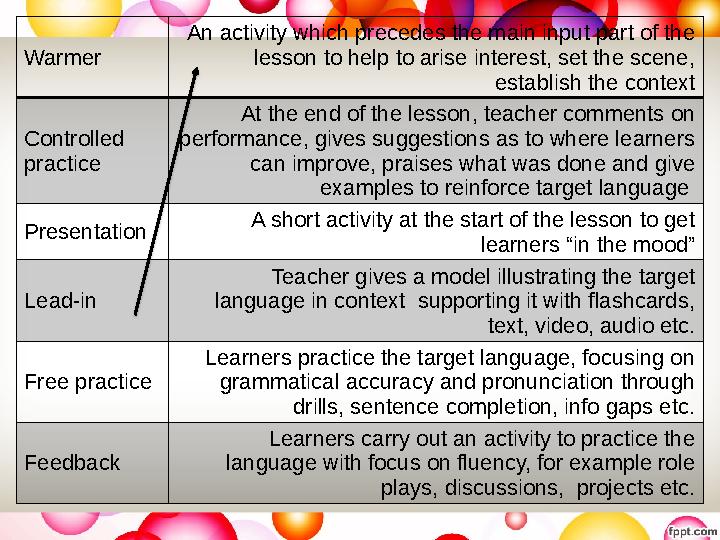
24 слайд
Warmer An activity which precedes the main input part of the
lesson to help to arise interest, set the scene,
establish the context
Controlled
practice At the end of the lesson, teacher comments on
performance, gives suggestions as to where learners
can improve, praises what was done and give
examples to reinforce target language
Presentation A short activity at the start of the lesson to get
learners “in the mood”
Lead-in Teacher gives a model illustrating the target
language in context supporting it with flashcards,
text, video, audio etc.
Free practice Learners practice the target language, focusing on
grammatical accuracy and pronunciation through
drills, sentence completion, info gaps etc.
Feedback Learners carry out an activity to practice the
language with focus on fluency, for example role
plays, discussions, projects etc.
24 слайд
Warmer An activity which precedes the main input part of the lesson to help to arise interest, set the scene, establish the context Controlled practice At the end of the lesson, teacher comments on performance, gives suggestions as to where learners can improve, praises what was done and give examples to reinforce target language Presentation A short activity at the start of the lesson to get learners “in the mood” Lead-in Teacher gives a model illustrating the target language in context supporting it with flashcards, text, video, audio etc. Free practice Learners practice the target language, focusing on grammatical accuracy and pronunciation through drills, sentence completion, info gaps etc. Feedback Learners carry out an activity to practice the language with focus on fluency, for example role plays, discussions, projects etc.
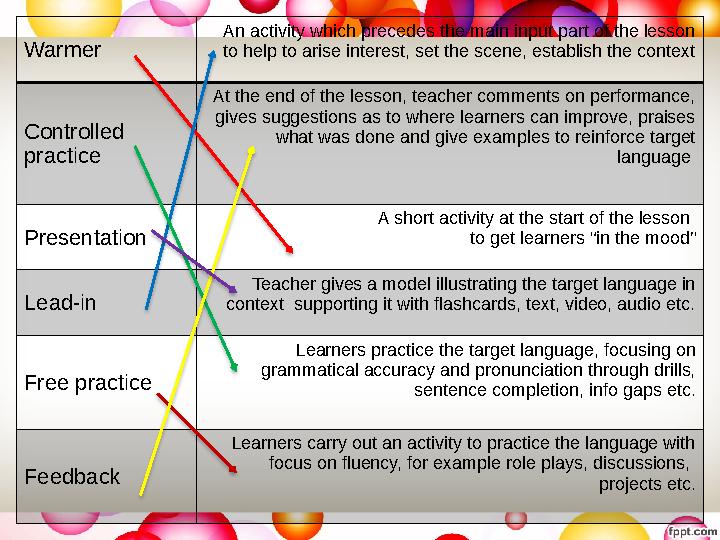
25 слайд
Warmer An activity which precedes the main input part of the lesson
to help to arise interest, set the scene, establish the context
Controlled
practice At the end of the lesson, teacher comments on performance,
gives suggestions as to where learners can improve, praises
what was done and give examples to reinforce target
language
Presentation A short activity at the start of the lesson
to get learners “in the mood”
Lead-in Teacher gives a model illustrating the target language in
context supporting it with flashcards, text, video, audio etc.
Free practice Learners practice the target language, focusing on
grammatical accuracy and pronunciation through drills,
sentence completion, info gaps etc.
Feedback Learners carry out an activity to practice the language with
focus on fluency, for example role plays, discussions,
projects etc.
25 слайд
Warmer An activity which precedes the main input part of the lesson to help to arise interest, set the scene, establish the context Controlled practice At the end of the lesson, teacher comments on performance, gives suggestions as to where learners can improve, praises what was done and give examples to reinforce target language Presentation A short activity at the start of the lesson to get learners “in the mood” Lead-in Teacher gives a model illustrating the target language in context supporting it with flashcards, text, video, audio etc. Free practice Learners practice the target language, focusing on grammatical accuracy and pronunciation through drills, sentence completion, info gaps etc. Feedback Learners carry out an activity to practice the language with focus on fluency, for example role plays, discussions, projects etc.

26 слайд
Put the components of the
lesson in the logical order
Warmer
Controlled practice
Presentation
Lead in
Free practice
Feedback
26 слайд
Put the components of the lesson in the logical order Warmer Controlled practice Presentation Lead in Free practice Feedback
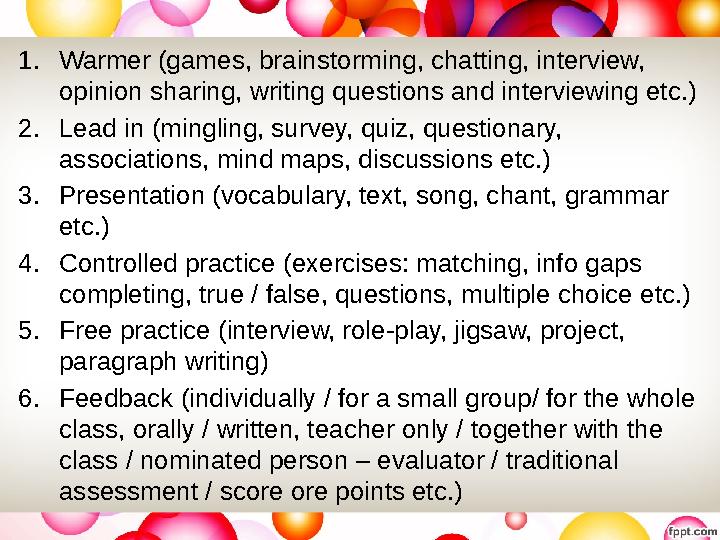
27 слайд
1. Warmer (games, brainstorming, chatting, interview,
opinion sharing, writing questions and interviewing etc.)
2. Lead in (mingling, survey, quiz, questionary,
associations, mind maps, discussions etc.)
3. Presentation (vocabulary, text, song, chant, grammar
etc.)
4. Controlled practice (exercises: matching, info gaps
completing, true / false, questions, multiple choice etc.)
5. Free practice (interview, role-play, jigsaw, project,
paragraph writing)
6. Feedback (individually / for a small group/ for the whole
class, orally / written, teacher only / together with the
class / nominated person – evaluator / traditional
assessment / score ore points etc.)
27 слайд
1. Warmer (games, brainstorming, chatting, interview, opinion sharing, writing questions and interviewing etc.) 2. Lead in (mingling, survey, quiz, questionary, associations, mind maps, discussions etc.) 3. Presentation (vocabulary, text, song, chant, grammar etc.) 4. Controlled practice (exercises: matching, info gaps completing, true / false, questions, multiple choice etc.) 5. Free practice (interview, role-play, jigsaw, project, paragraph writing) 6. Feedback (individually / for a small group/ for the whole class, orally / written, teacher only / together with the class / nominated person – evaluator / traditional assessment / score ore points etc.)

28 слайд
Home task
•
Read lecture “Lesson planing”
•
Read article “Creating a lesson plan”
•
Independent № 9 Creating a lesson plan
•
Questionary “Preparing your own
resources”
28 слайд
Home task • Read lecture “Lesson planing” • Read article “Creating a lesson plan” • Independent № 9 Creating a lesson plan • Questionary “Preparing your own resources”

29 слайд
Seminar
•
Divide into groups of 3 – 4 students.
•
Choose a topic from F&F 2 (school things, feelings, outdoor
activities, food, numbers, school subjects, school rooms, after
school activities, special days, every day activities, places,
weather, clothes, time, animals, adjectives, memories, people)
•
Prepare a demo lesson based on the material from F&F2
(vocabulary, text, song etc.)
•
Follow the scheme (all the stages must be shown in the given
order)
•
Every person is responsible for 1 or 2 stages of the lesson
•
Think beforehand about teaching aids.
•
Prepare written plan of your stage, write the aim.
•
Remember all the stages are parts of one lesson therefore
think about logical connection and time management.
29 слайд
Seminar • Divide into groups of 3 – 4 students. • Choose a topic from F&F 2 (school things, feelings, outdoor activities, food, numbers, school subjects, school rooms, after school activities, special days, every day activities, places, weather, clothes, time, animals, adjectives, memories, people) • Prepare a demo lesson based on the material from F&F2 (vocabulary, text, song etc.) • Follow the scheme (all the stages must be shown in the given order) • Every person is responsible for 1 or 2 stages of the lesson • Think beforehand about teaching aids. • Prepare written plan of your stage, write the aim. • Remember all the stages are parts of one lesson therefore think about logical connection and time management.



